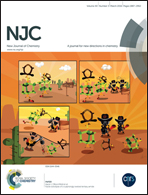Exploring excited state properties of 7-hydroxy and 7-methoxy 4-methycoumarin: a combined time-dependent density functional theory/effective fragment potential study†
Abstract
The effective fragment potential (EFP) method of solvation interfaced with the density functional theory (DFT) was applied to investigate the hydrogen bonding (HB) sites of 7-hydroxy-4-methylcoumarin (4MU (4-methylumbelliferone)) and 7-methoxy-4-methylcoumarin (MMC) in water. The original EFP model (EFP1) was used to form 4MU–(H2O)5, 4MU−–(H2O)5, 4MUT–(H2O)5 (keto tautomer of 4MU) and MMC–(H2O)2 complexes. A hydrogen bond network was formed by three water molecules between the oxygen of the carbonyl group and hydrogen (oxygen) of the hydroxyl group. Five HBs were formed by 4MU and 4MUT with water molecules; two C![[double bond, length as m-dash]](https://www.rsc.org/images/entities/char_e001.gif) O⋯H (B type), one C–O⋯H (B′ type), one by the oxygen of the pyrone ring with the hydrogen of the hydroxyl group or water molecule (B′′ type) and one O–H⋯O (type C). 4MU− also formed five HBs; two B type, two B′ type and one B′′ type. Two HBs are formed by MMC; one B type and one B′ type. The excited state properties were computed using the state-specific time dependent density functional theory (SS-TDDFT) combined with the polarizable continuum model (PCM) and EFP1 method. The excited state hydrogen transfer (ESHT) was found in the first excited (S1) state of 4MU. C–OH bond contracting, O–H bond stretching and O–H⋯O HB strengthening suggests the possibility of hydrogen transfer from the hydroxyl group to a water molecule and water molecule to the carbonyl group at the S1 state. Natural charge analysis manifests the intramolecular charge transfer (ICT) of 4MU chromophore in the S1 state, and the calculated electronic absorption and fluorescence spectra of 4MU, 4MU− and 4MUT in water revealed the tendency of hydrogen transfer in the S1 state. The change in HB energy between the 4MU–(H2O)5 complex at the S0 state and the 4MUT–(H2O)5 complex at the S1 state confirms the formation of the 4MUT–(H2O)5 complex at the first excited state.
O⋯H (B type), one C–O⋯H (B′ type), one by the oxygen of the pyrone ring with the hydrogen of the hydroxyl group or water molecule (B′′ type) and one O–H⋯O (type C). 4MU− also formed five HBs; two B type, two B′ type and one B′′ type. Two HBs are formed by MMC; one B type and one B′ type. The excited state properties were computed using the state-specific time dependent density functional theory (SS-TDDFT) combined with the polarizable continuum model (PCM) and EFP1 method. The excited state hydrogen transfer (ESHT) was found in the first excited (S1) state of 4MU. C–OH bond contracting, O–H bond stretching and O–H⋯O HB strengthening suggests the possibility of hydrogen transfer from the hydroxyl group to a water molecule and water molecule to the carbonyl group at the S1 state. Natural charge analysis manifests the intramolecular charge transfer (ICT) of 4MU chromophore in the S1 state, and the calculated electronic absorption and fluorescence spectra of 4MU, 4MU− and 4MUT in water revealed the tendency of hydrogen transfer in the S1 state. The change in HB energy between the 4MU–(H2O)5 complex at the S0 state and the 4MUT–(H2O)5 complex at the S1 state confirms the formation of the 4MUT–(H2O)5 complex at the first excited state.


 Please wait while we load your content...
Please wait while we load your content...